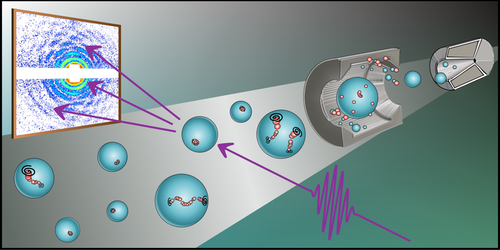Bigger Helium Nanodroplets without the Swirls
The frictionless environments of helium nanodroplets makes them perfect for studying the self-organization of atoms and molecules. However, if there are vortices inside these nanodroplets, this can hinder the assembly of some of these nanostructures. Now Anatoli Ulmer from the Technical University of Berlin and colleagues have developed a method for generating vortex-free helium nanodroplets with 1000 times more helium atoms than previously possible [1]. The advance could enable researchers to study the self-assembly of a larger range of molecules.
One way that researchers form helium nanodroplets is via a condensation process that involves passing helium gas through a 5-µm-diameter pinhole. This process creates mostly vortex-free droplets containing up to about 105 helium atoms. These droplets however are too small to use in studies of self-assembled nanostructures, as they cannot be resolved in images. Ulmer and his colleagues instead explored conical nozzles, which are known to promote the formation of larger nanodroplets. According to the team’s calculations, generating droplets this way should also impart limited angular momentum to the droplets, reducing the likelihood that vortices form.
The team passed helium gas through a conical nozzle that increased in diameter from 150 µm to 1 mm across its 9.3-mm length. The group found that the resulting droplets were close to spherical and contained 107 to 1011 helium atoms, making them large enough to resolve. The smaller of these nanodroplets, those with about 107 atoms, were mostly vortex free, while the larger ones contained vortices. The researchers say that they aspire to develop the capability for on-demand production of helium droplets with precise sizes. That could allow controlled experiments on the self-assembly of atoms and molecules, allowing researchers to study how the geometries of the self-assembled structures change with increasing particle number.
Correction (18 August 2023): A previous version of this story misstated how many more helium atoms the new vortex-free nanodroplets can contain. It is 1000 times more, not 1000 more.
–Martin Rodriguez-Vega
Martin Rodriguez-Vega is an Associate Editor for Physical Review Letters.
References
- A. Ulmer et al., “Generation of large vortex-free superfluid helium nanodroplets,” Phys. Rev. Lett. 131, 076002 (2023).




